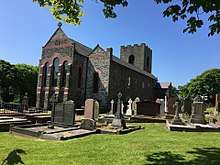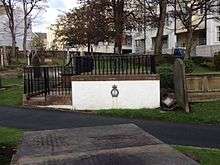St George's Church, Isle of Man
| St George's Church | |
|---|---|
 St George's Church, Douglas, Isle of Man | |
 St George's Church | |
| 54°08′58″N 4°29′09″W / 54.1494°N 4.4857°WCoordinates: 54°08′58″N 4°29′09″W / 54.1494°N 4.4857°W | |
| Location | Upper Church Street, Douglas, Isle of Man. |
| Country | Isle of Man |
| Denomination | Church of England |
| Tradition | Conservative evangelical |
| Website | Church website |
| History | |
| Status | Parish church |
| Founded | 1761 |
| Dedication | Saint George |
| Consecrated | 29 September 1781 |
| Architecture | |
| Functional status | Active |
| Style | Gothic Revival |
| Groundbreaking | 1761 |
| Completed | 1781 |
| Construction cost | Approximately £1,500 |
| Specifications | |
| Capacity | 1,300 |
| Administration | |
| Parish | St George and All Saints |
| Diocese | Diocese of Sodor and Man |
| Clergy | |
| Vicar(s) | Rev Andrew Brown |
St George's Church is an Anglican church in Douglas, Isle of Man and falls within the Diocese of Sodor and Man. It was formerly one of two worship centers in association with All Saints Church, Douglas.
History
In the early 1700s the population of Douglas comprised approximately 800 people, and at this time the first St Matthew's Church served as the centre of worship for the population. However with the rise in population attributed to the Isle of Man's smuggling trade (known on the Island as the Running Trade) the prosperity of the town began to increase dramatically.
By the mid part of the 18th Century the population of the town had swelled to over 3,000 which in turn led to calls for a new church in order to meet demand, St Matthew's proving to be inadequate for purpose.
Construction
Initial construction
Land was sourced on the outskirts of the town, high on a hill overlooking Douglas Harbour, and which at the time was situated in the Parish of Braddan. It was the town's gentry (some of whom had profited handsomely from the running trade) who met the initial cost of the undertaking, raising the necessary money by public subscription. By 1761 the amount raised totaled £712
(£101,000 in 2018), but after four years money had run out and worked subsequently stopped.
Completion and consecration
Nothing more happened until 1776, when with further money raised work recommenced. An additional sum of £800
(£99,000 in 2018) had been raised enabling work to be completed with the church being consecrated on 29 September 1781. In order to pay off the subsequent debts accrued by the construction a charge of 25 guineas was made for a first class pew and 15 guineas for a second class pew.
Said to of been a proud symbol to the people of Douglas, the completed church could accommodate 1,300 worshipers and the church received several fine embellishments from various benefactors. Notable amongst these were a silver communion service, made by a renowned London silversmith and which was donated by the John Murray, 4th Duke of Atholl, with a later addition being a stained glass window which was funded by Henry Noble.
Numerous people of local society have been buried in the churchyard, including such as Sir William Hillary and Nelly Brennan. On the top side of the church yard lies an open grassed area, marked with a solitary cross, and which was used for the mass burial of cholera victims during the outbreaks which affected Douglas in 1832 and 1833.
Organ
The church organ of St George's was the first to be installed in any church on the Isle of Man. The organ was made in 1741 by the renowned Harris & Byfield[1] and was acquired from the Dublin Assembly Hall in 1778 by one of the St George's Trustees for the sum of £100
(£12,000 in 2018).[1]
It is the organ on which George Frideric Handel conducted the first performance of the messiah which took place in Dublin in 1742.[1] The organ was installed at St George's in 1778 and enriched the musical life of the Isle of Man, with people from all over the Island making their way into Douglas to listen to it.
One of the first people to play the organ was Charles Barrow grandfather of Charles Dickens. The organ was stripped down and rebuilt in 1950, the work being undertaken by Jardine's of Manchester for the sum of £3,985
(£125,000 in 2018).[1]
Modern use
Today St George's Church continues to play an active part within the life of the local community.
Notable gravesites
- Sir William Hillary; celebrated philanthropist and founder of the Royal National Lifeboat Institution.
- Nelly Brennan; heroine of cholera outbreaks.
Gallery
 Mass grave of victims of the cholera outbreaks; 1832 & 1833
Mass grave of victims of the cholera outbreaks; 1832 & 1833.jpg) Information on the activities at St George's Church
Information on the activities at St George's Church The grave of Sir William Hillary.
The grave of Sir William Hillary.